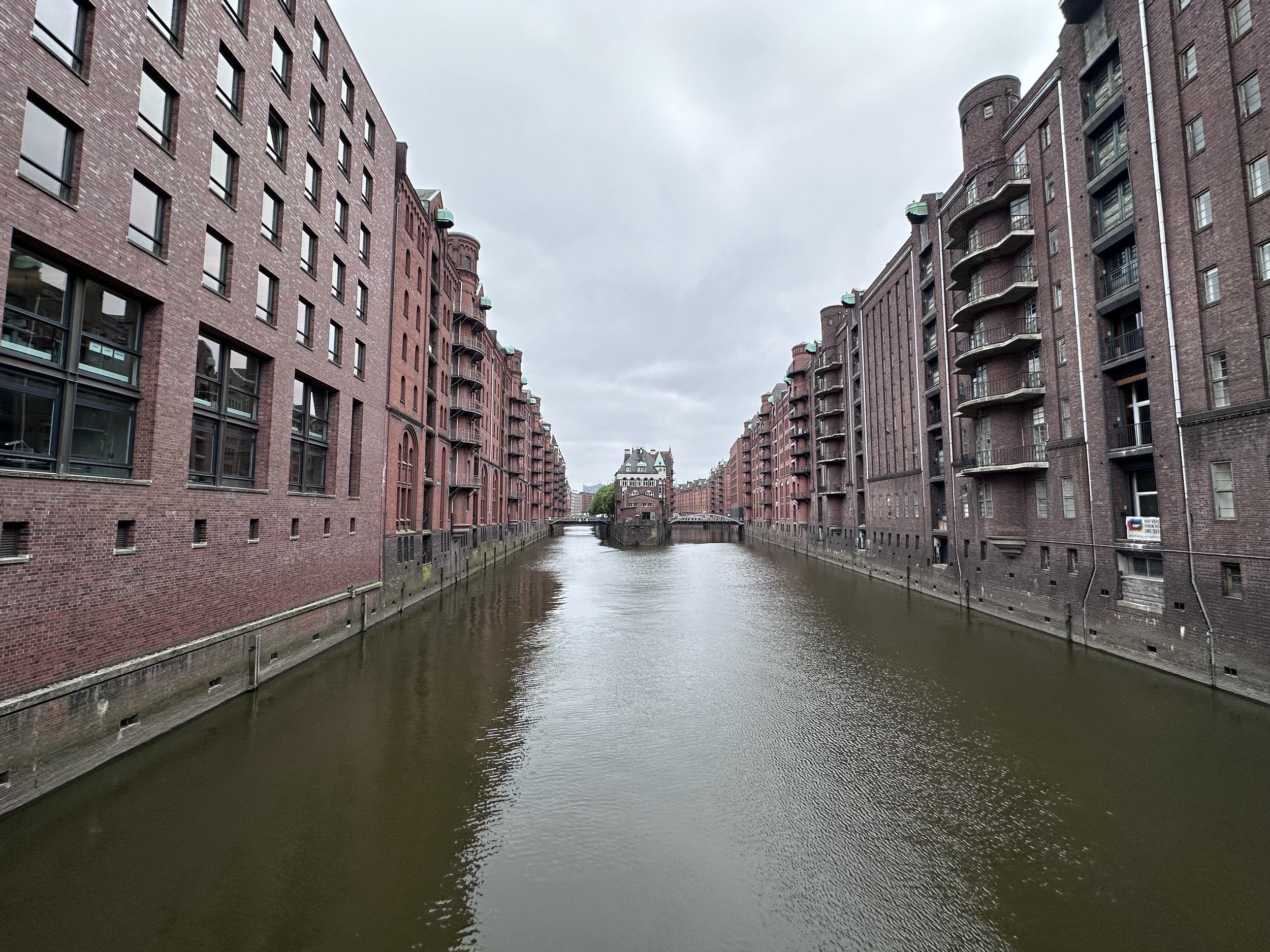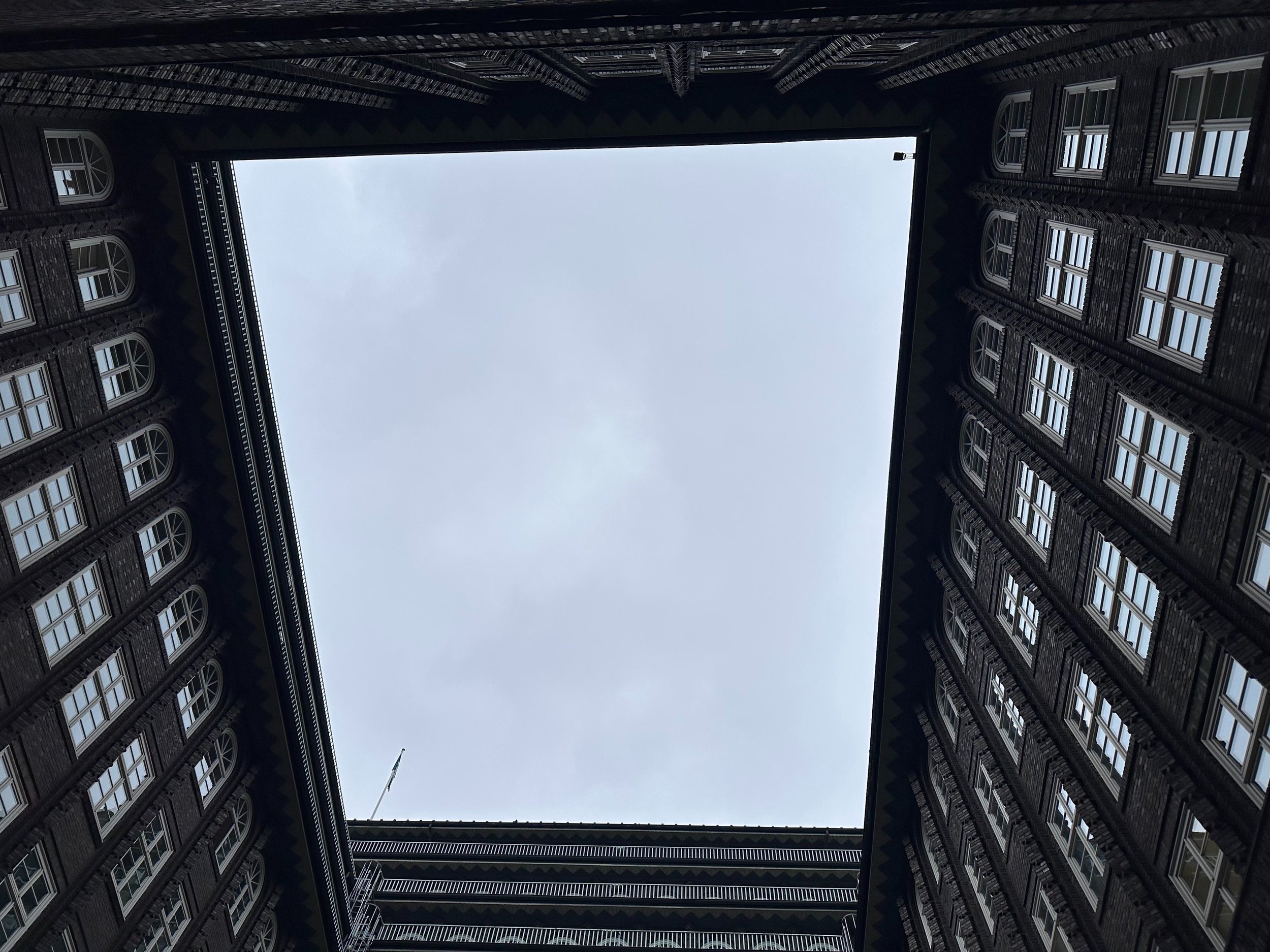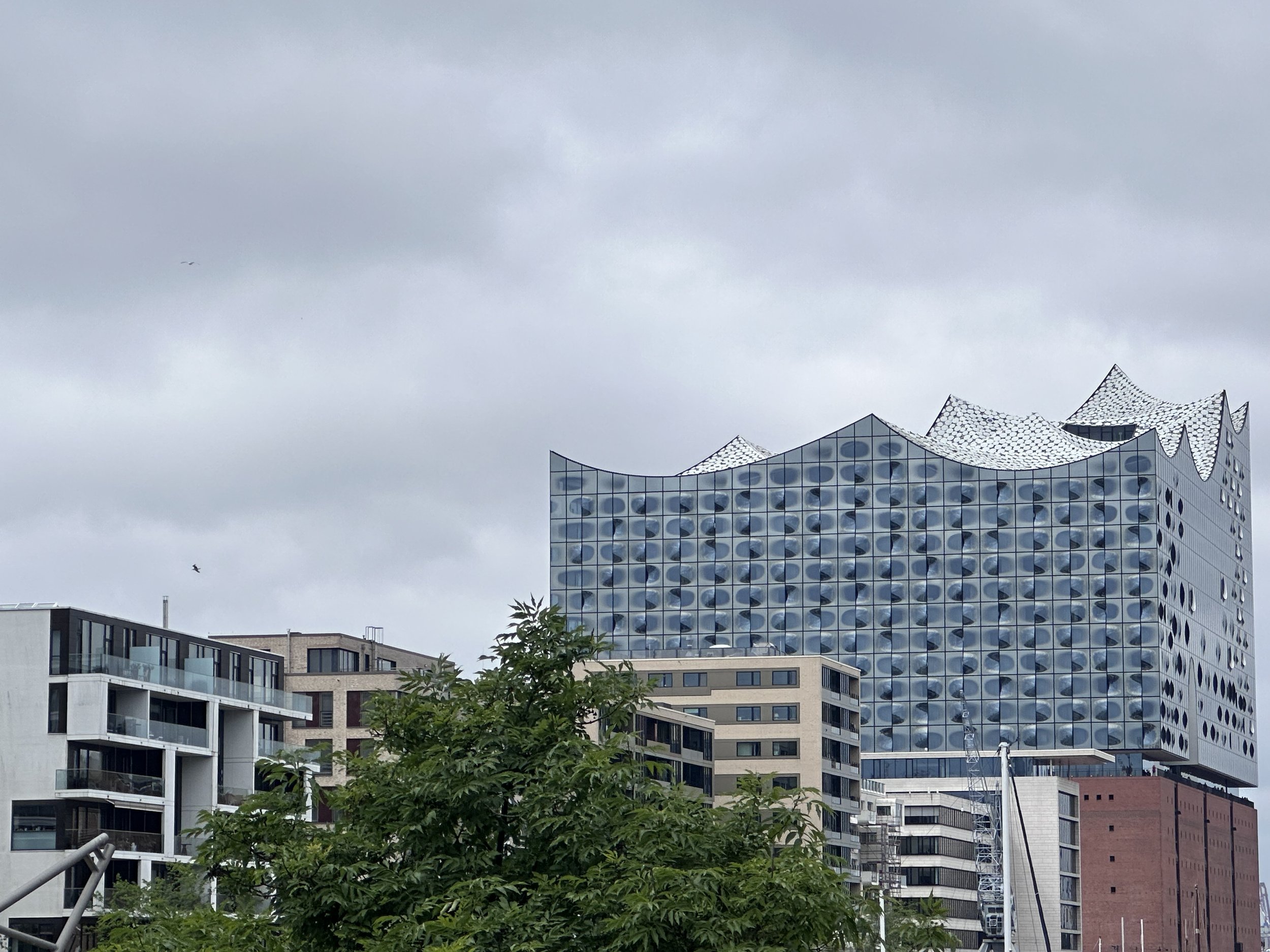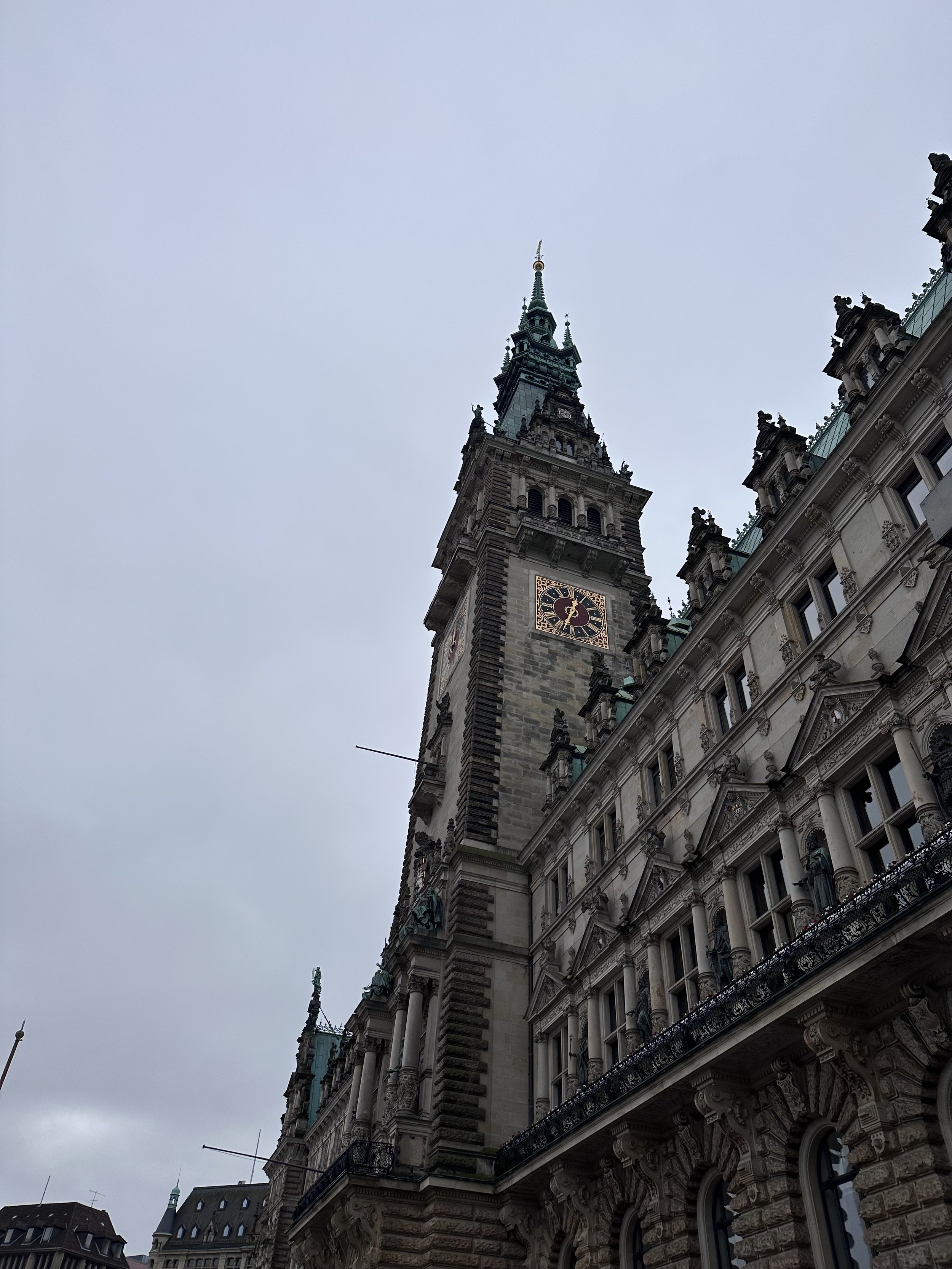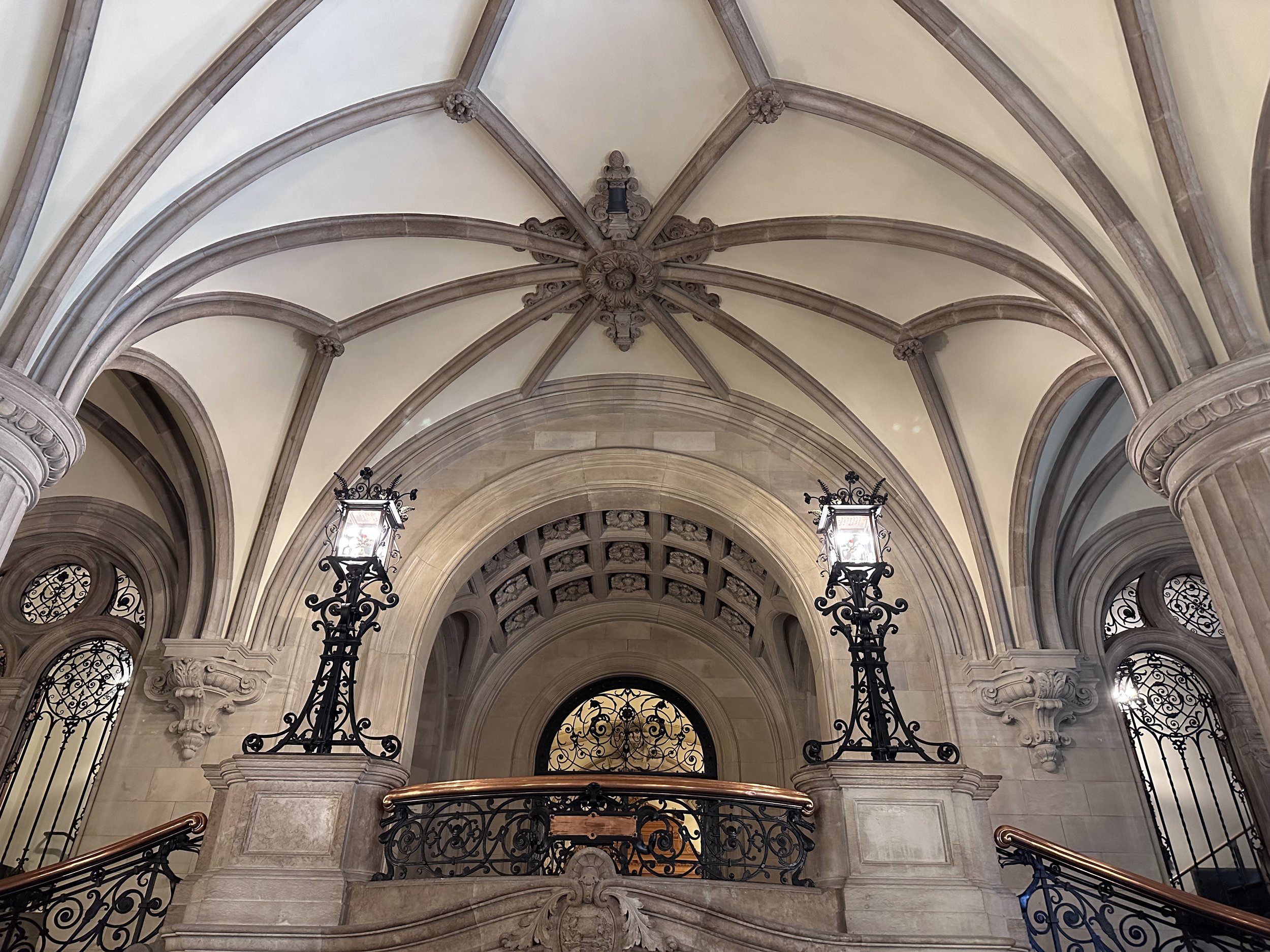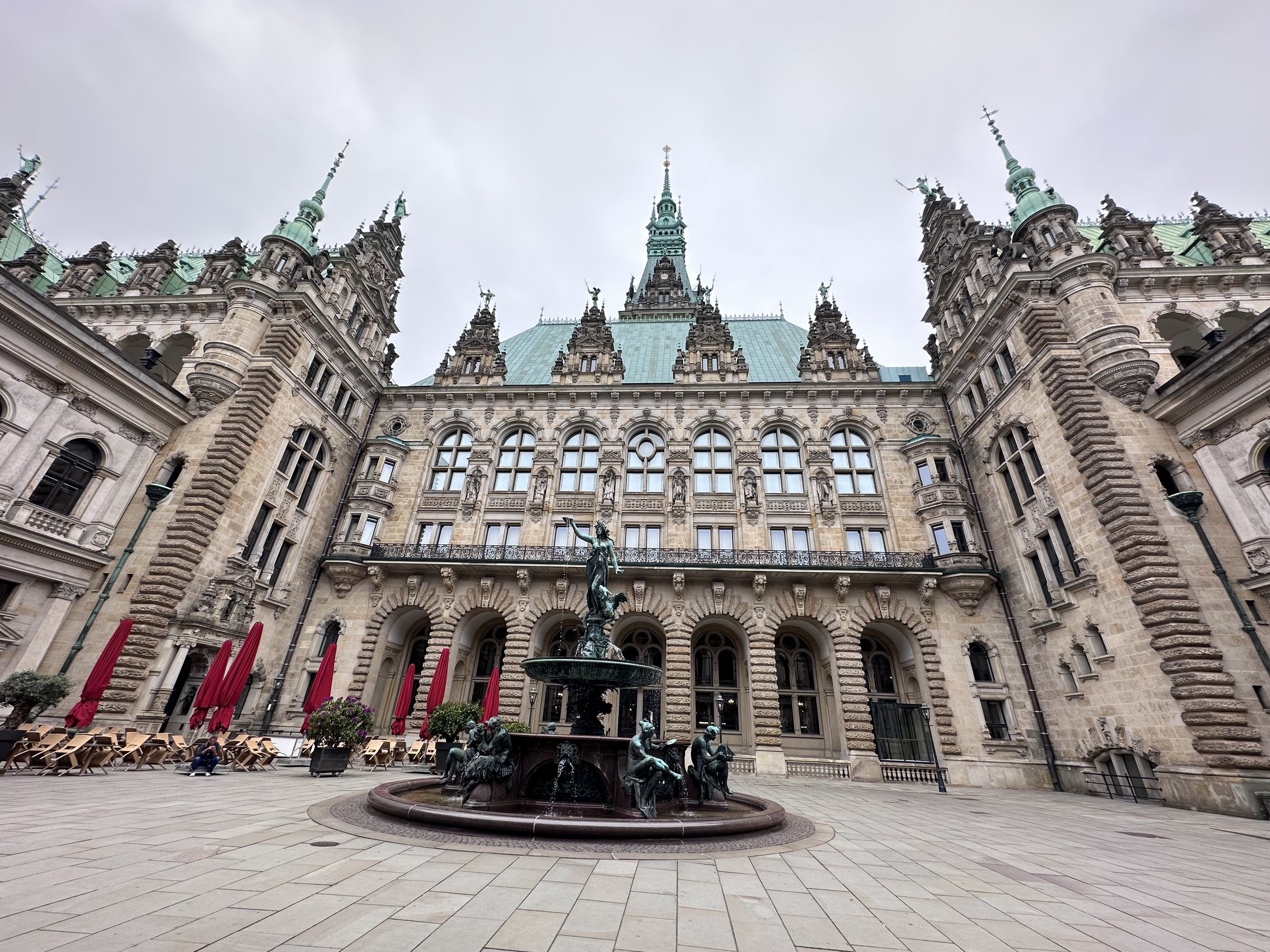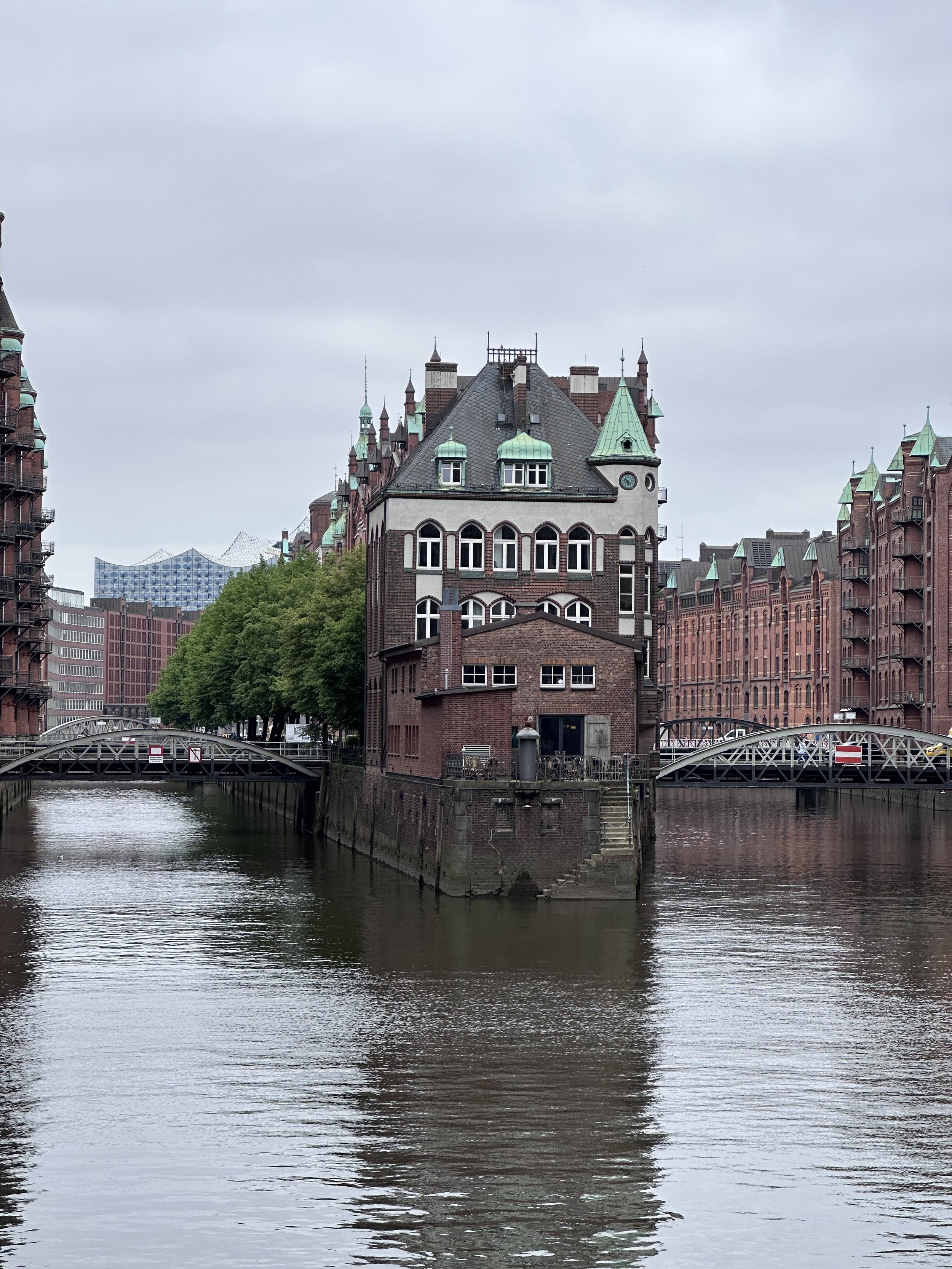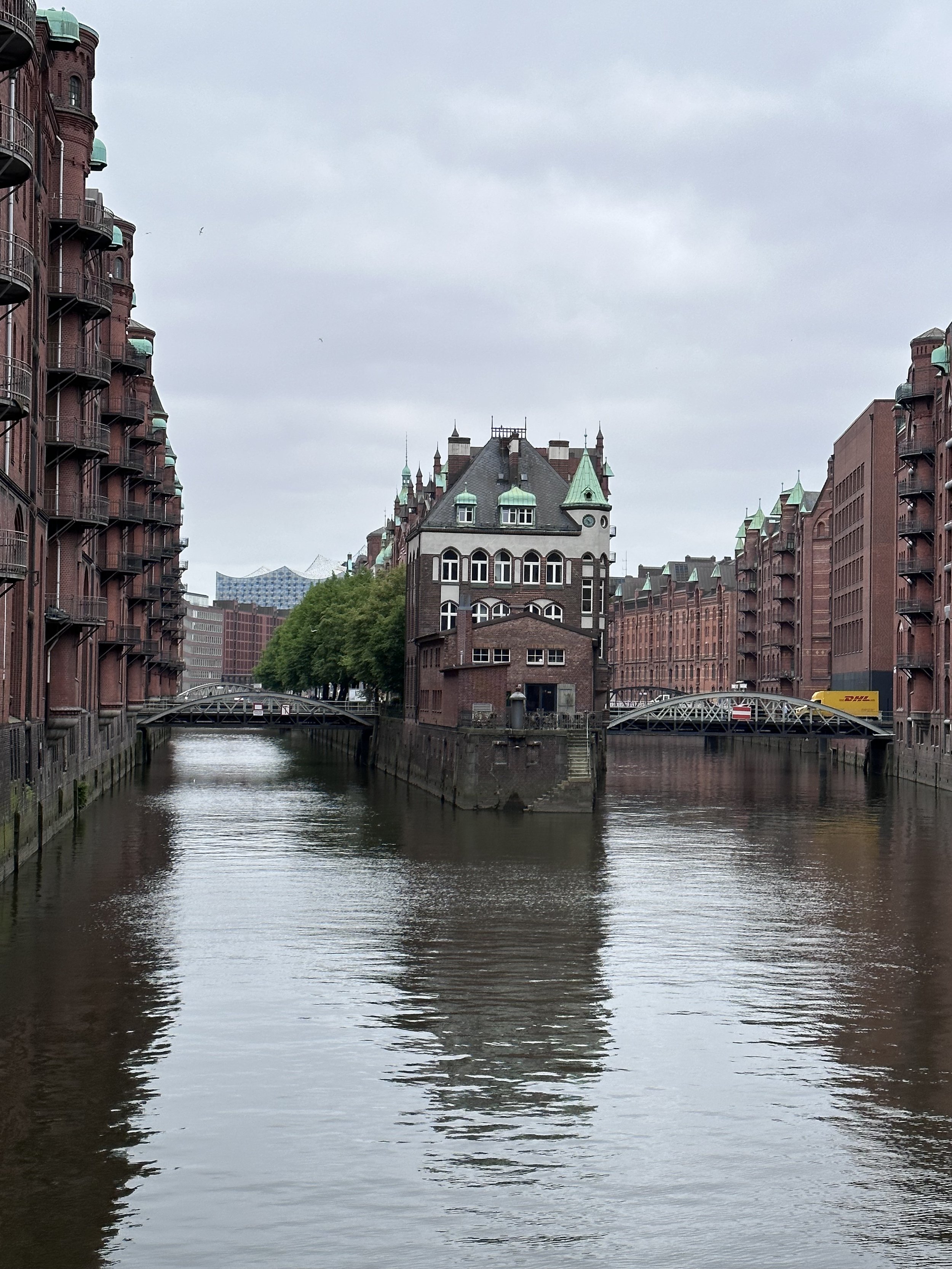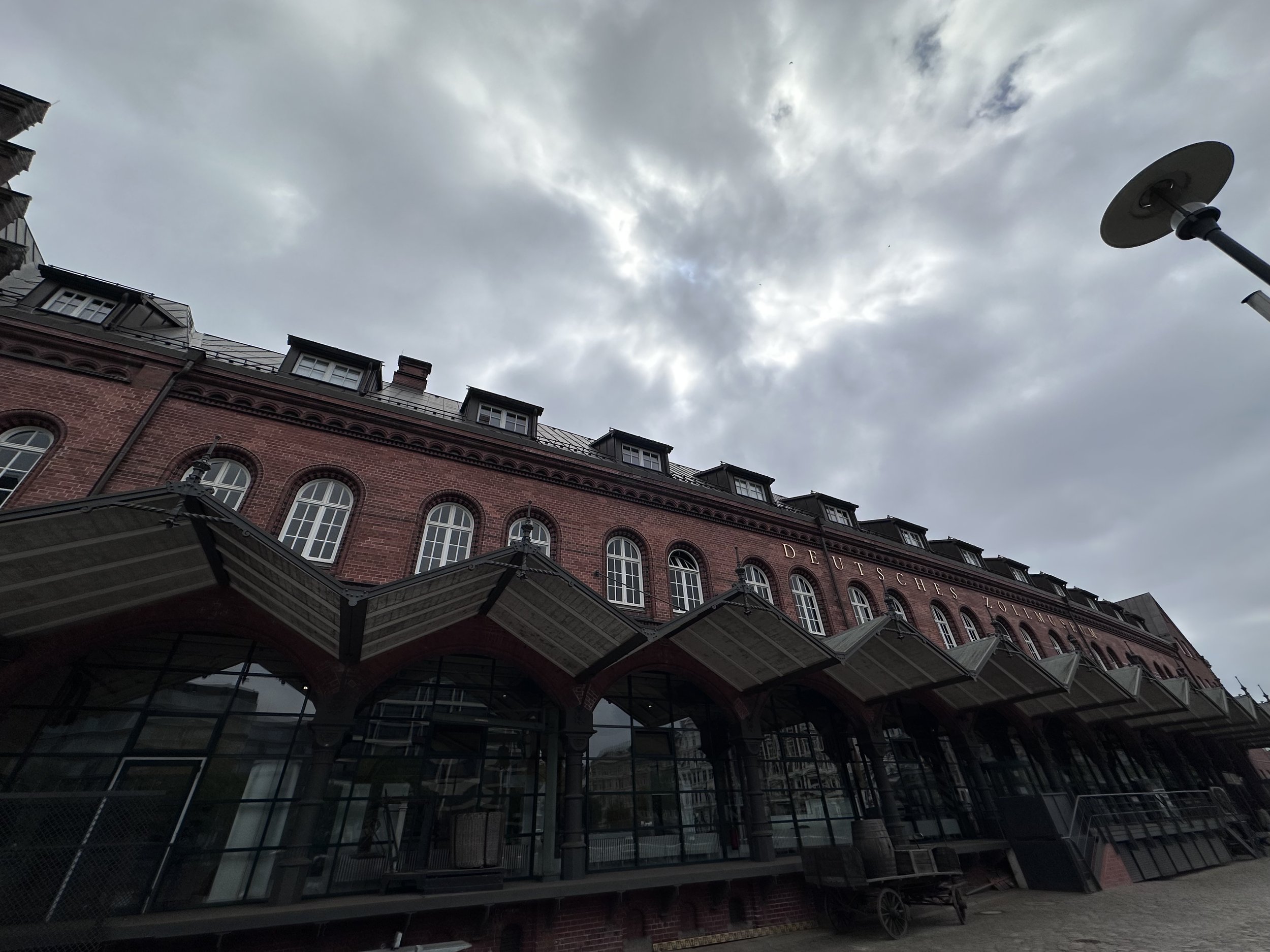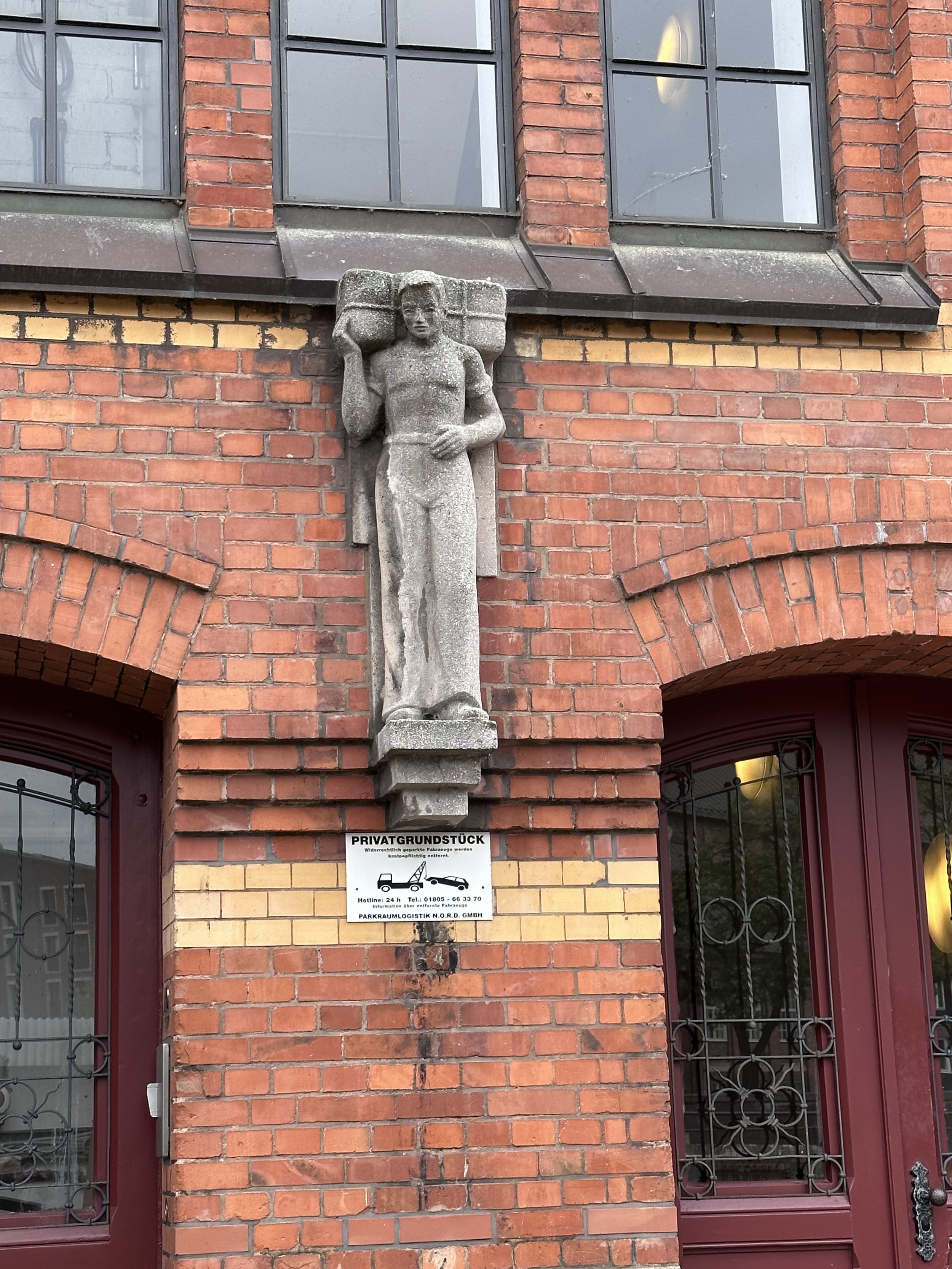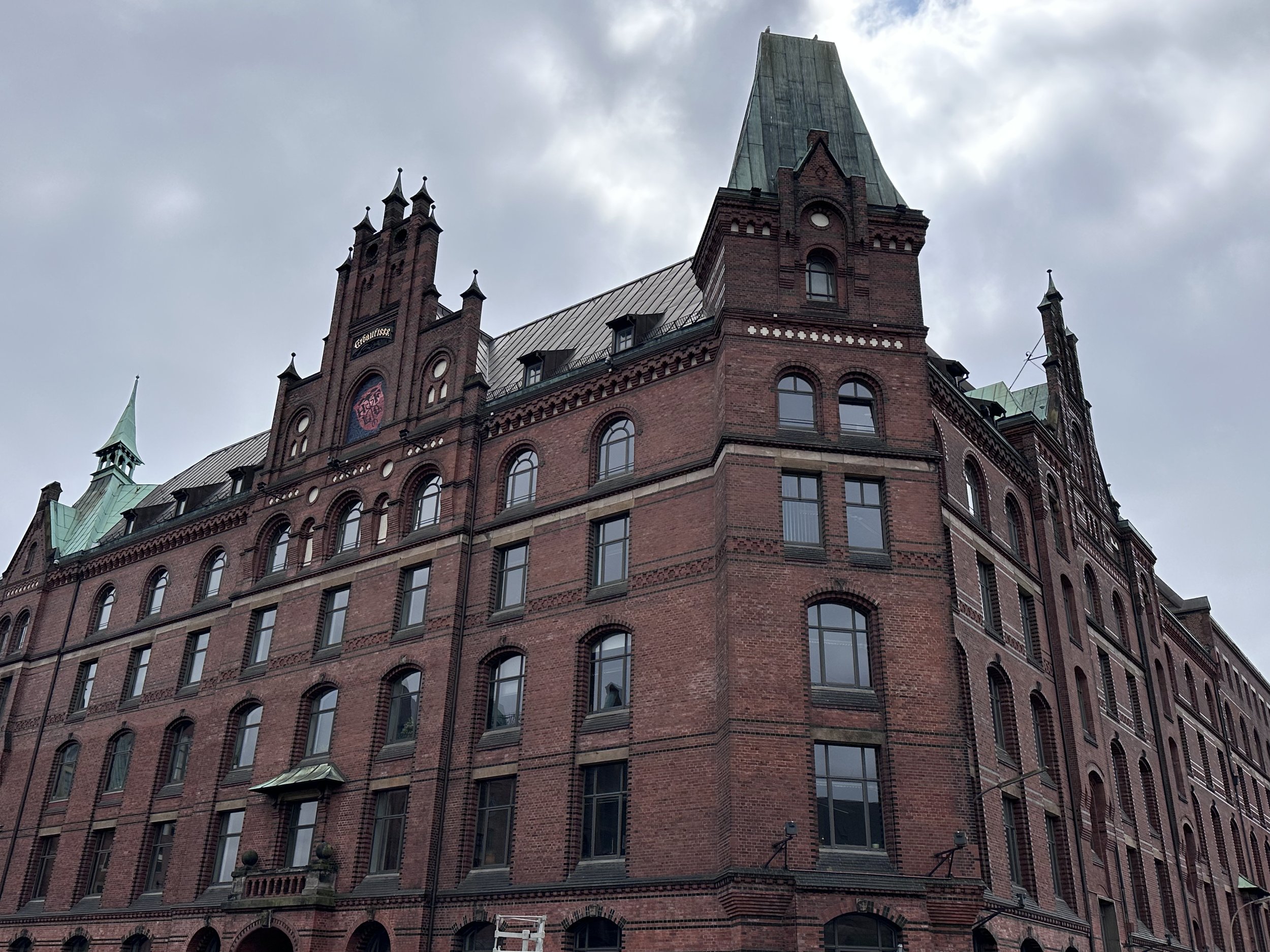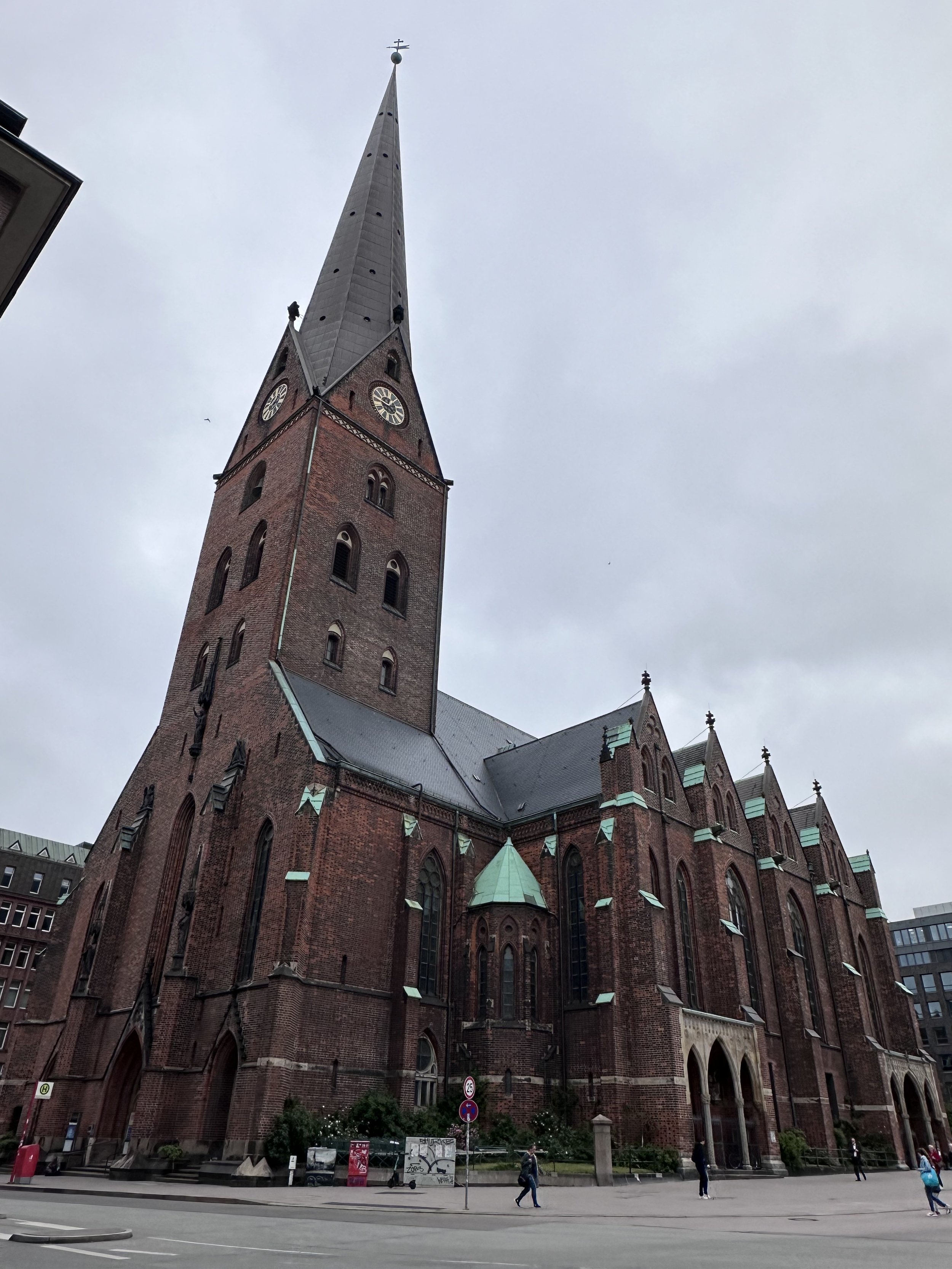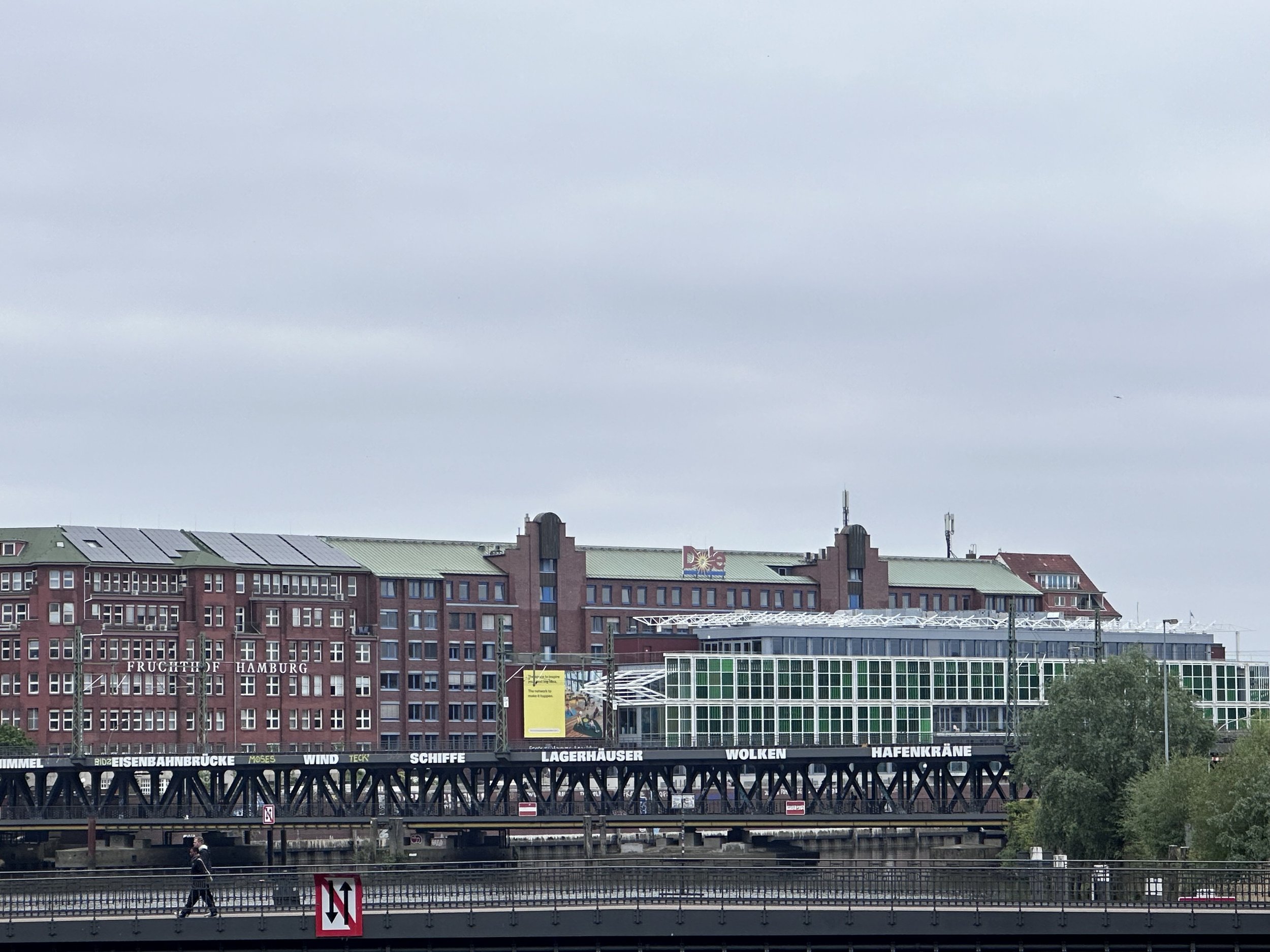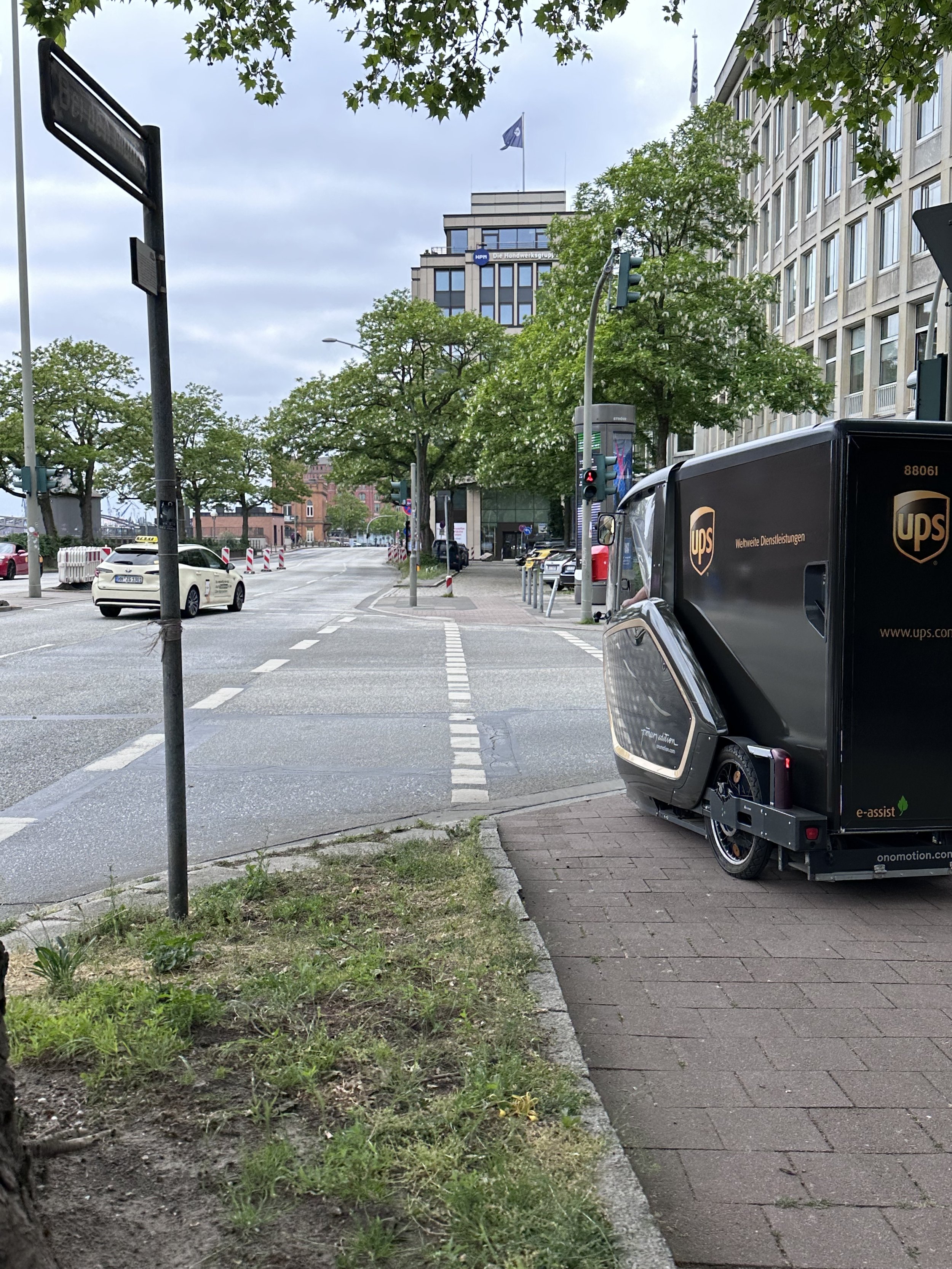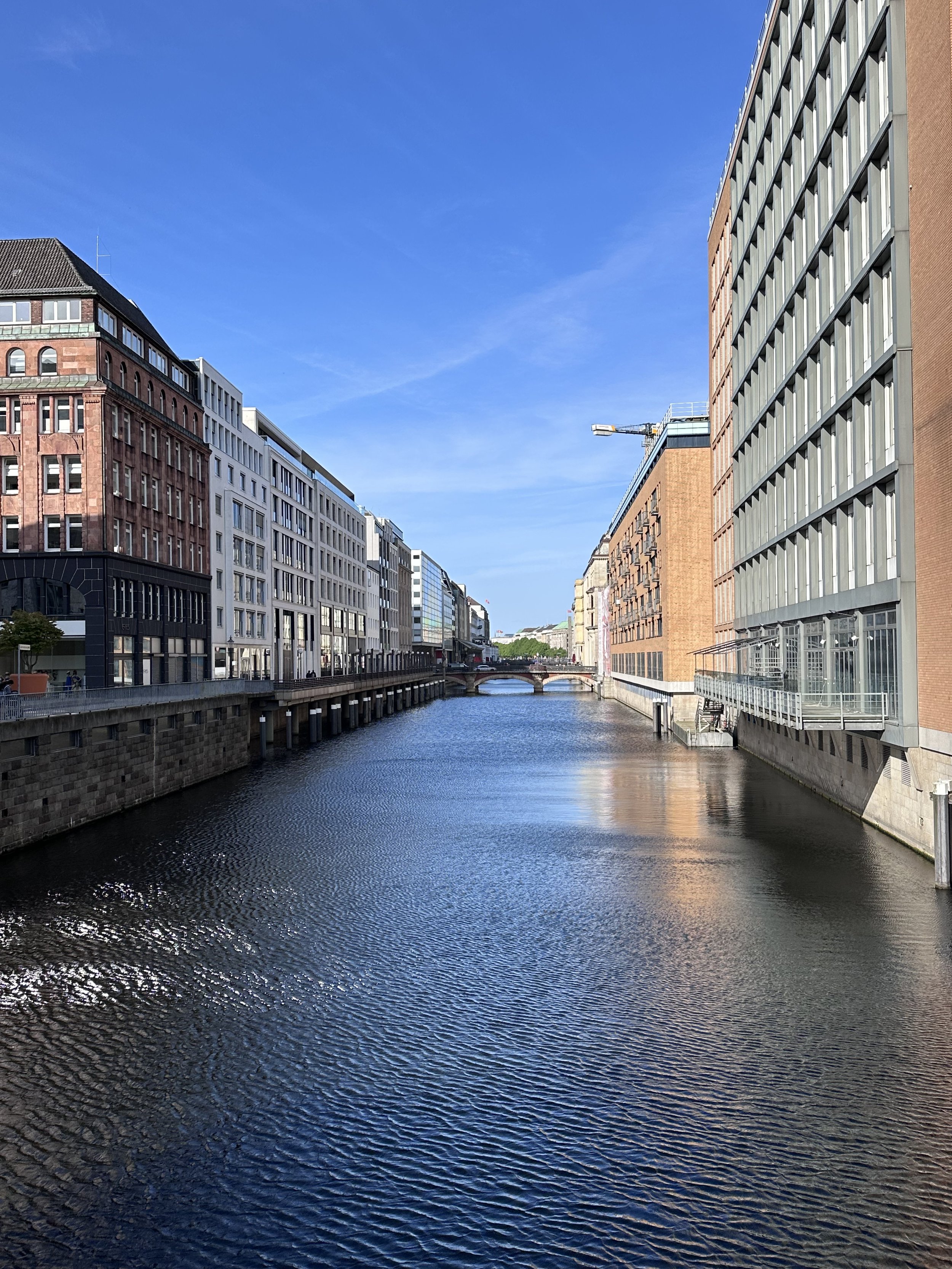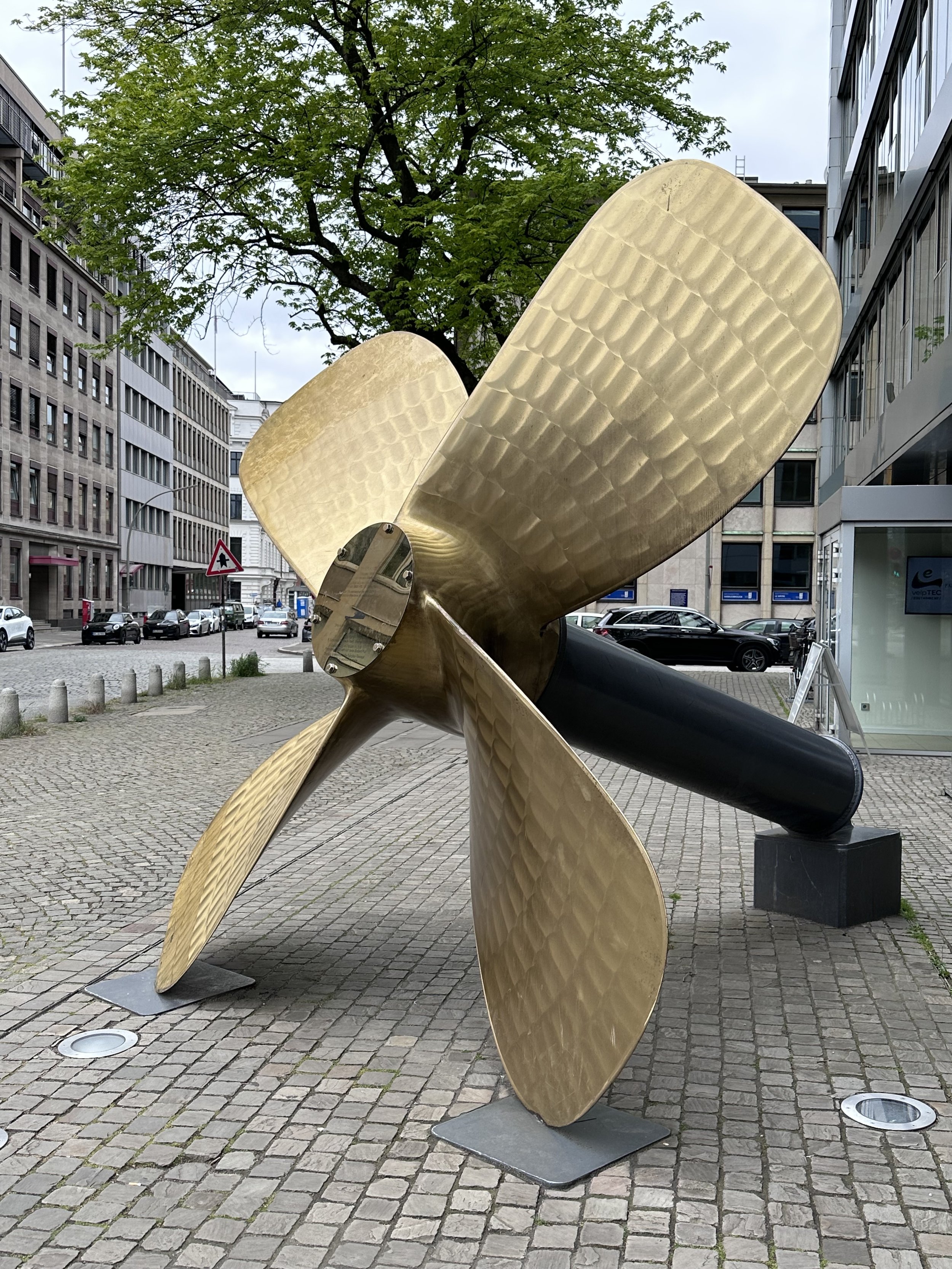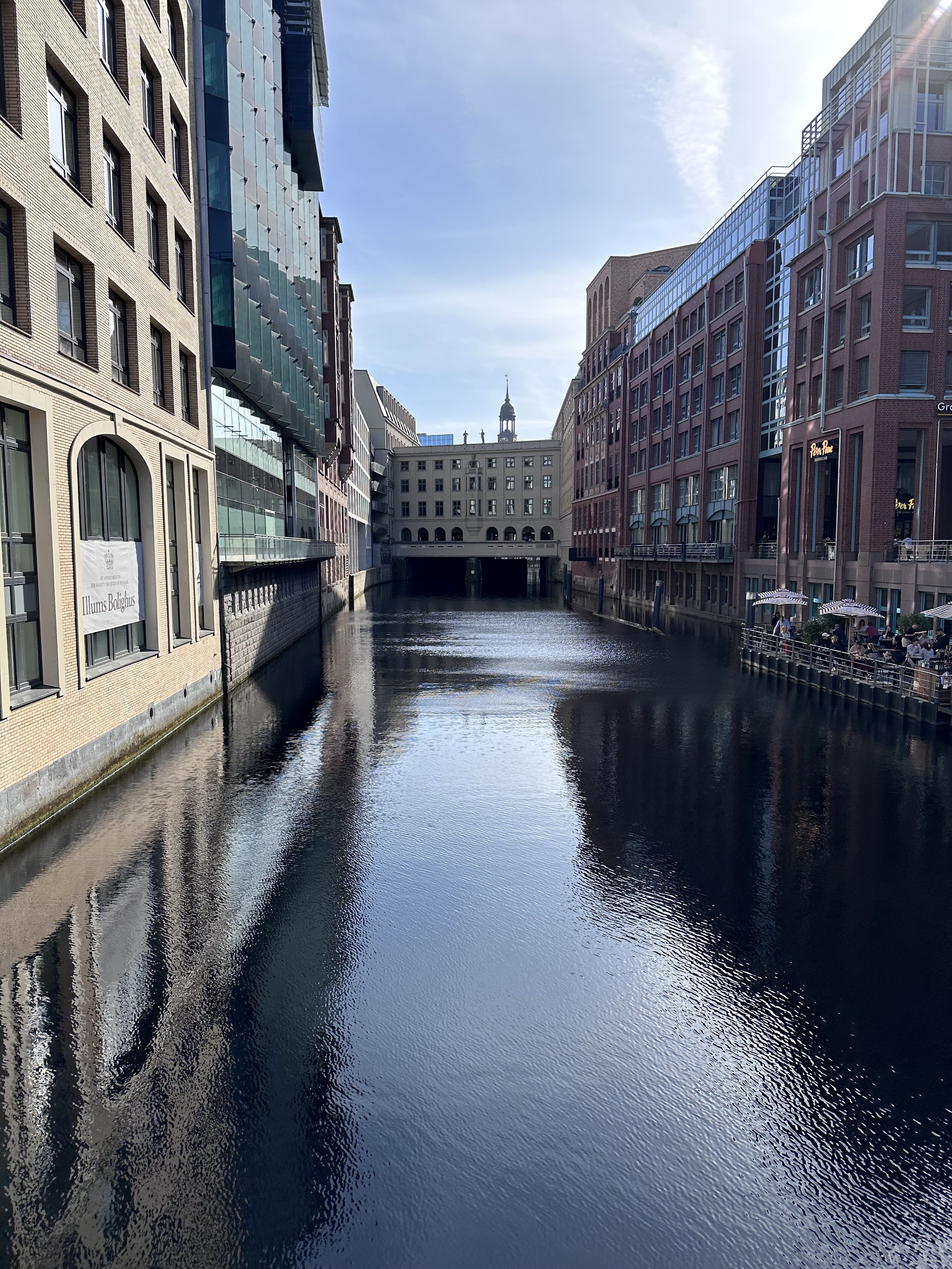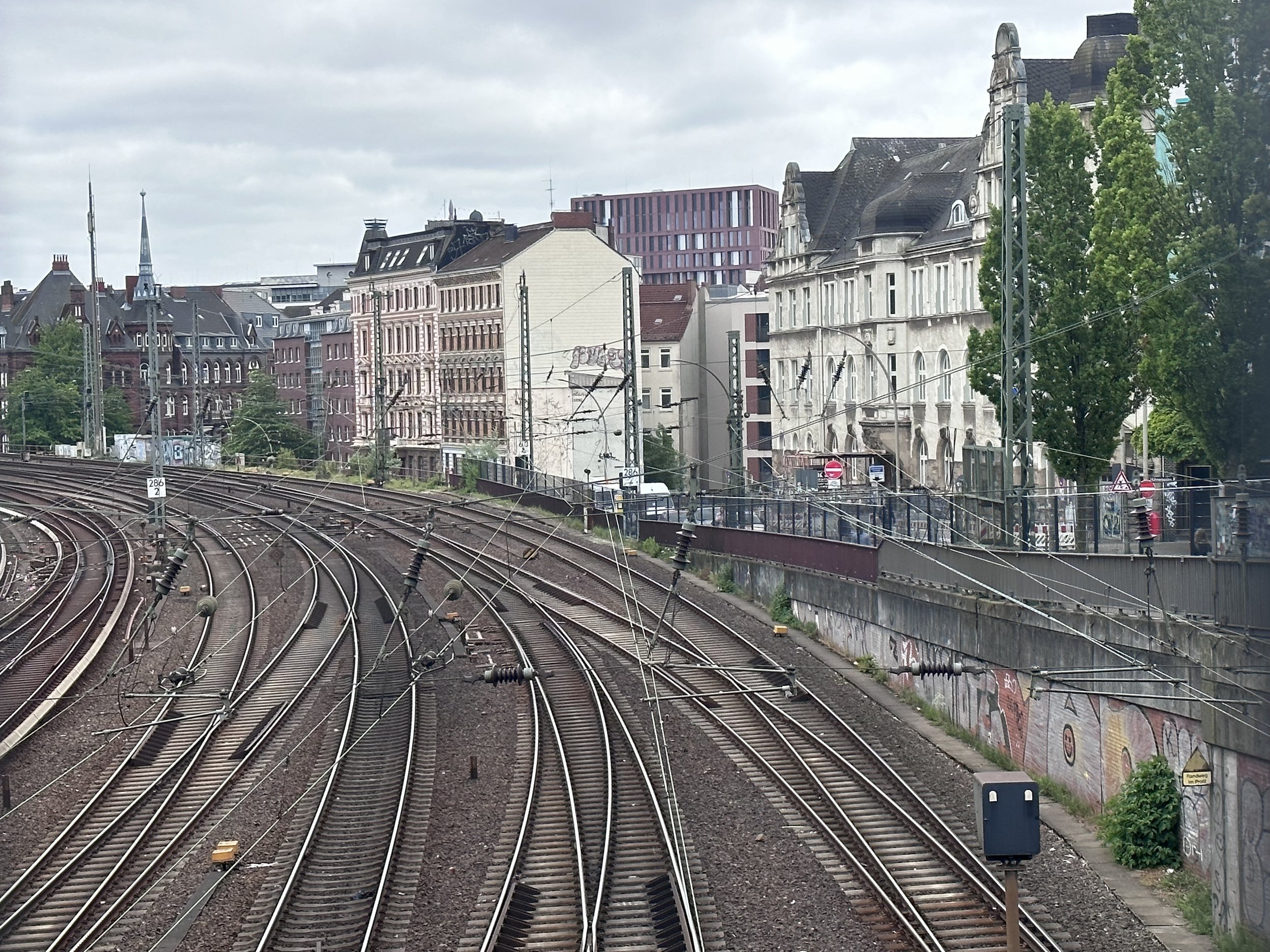Exploring Hamburg, Germany
Time needed in this city: 2-3 nights (more if you are taking day trips)
Hamburg is one of those cities worth seeing once. Once a heavily war-torn area is now shifting to a younger, vibrant feel with some great things to see and do. While you only need two days to see it all, make sure to put it on your list. Also, use it as a “base” location to take day trips to other parts of the country, such as Bremen and Lübeck.
The below information is a complete guide of the best places to stay, the top rated places to dine and drink, and all there is to see and do. We’ve also included transportation tips, as well as a summary of the history of this industrial city!
Jump To:
Where to Stay
Fraser Suites
We chose Fraser Suites for our stay as we wanted to be near the higher end brands of hotels for our first time (a practice I adopted long ago with first visits to foreign cities). It is absolutely our recommendation to stay there as it’s a repurposed historical tax building that holds all of it’s old luxury, charm, and character. It also only contains mini suites with mini kitchens (there’s a supermarket across the street that we frequented), spacious bathrooms and work areas, as well as comfortable beds.
other recommendations
Where to Dine & Drink
Blackbeard and I believed that gluten-free might be hard to come by in Germany but it certainly wasn’t! In fact, we’re learning that most of Europe caters to this diet better than anywhere else in the world. If you have Celiac or you prefer this diet, here are the two words you should know, “Glutenfreie” (gluten-free) and “Weizen” (wheat). This will help you navigate grocery stores and menus if needed.
100/200 Kitchen
Earning two Michelin stars and one Michelin green star, they serve a changing seasonal menu with elegant plate presentations & wine, in a funky warehouse setting. They are open from 6pm - 11pm.
ASHOKA Indisches
They serve curries, biryanis, and a pre- or post-theater thali menu. They are open from 5pm - 11pm.
bianc
Earning two Michelin stars, they offer a fixed-price menu of Mediterranean cuisine and wine. They are open from 6:30pm - midnight.
Bootshaus Grill & Bar - Hafencity
Chic restaurant serving steak and seafood in a warm space that has patio seating & harbor views. They are open from 5:30pm - midnight.
Deichgraf
They serve salted meat labskaus and other northern specialities in a posh dining room or on a sidewalk terrace. They are open from noon - 3pm and 5:30pm - 9pm.
Erdapfel
Laid-back restaurant whipping up stuffed baked potatoes with a variety of veggie toppings. They are open from 11:30am - 9pm.
This was the first restaurant we tried in Hamburg and it was really good, though don’t expect bacon and real cheese. We found out later it was an all-vegan baked potato place. If you don’t care, then we highly recommend checking it out. Watch Blackbeard’s video short, here.
Estancia Steaks
Serves individually plated cuts of premium beef, offered with sides & gin in a modern space with a patio. They are open 12:30pm - 3pm for lunch and 5:30pm - 10pm for dinner.
HACO
Earning one Michelin green star for sustainability, they serve refined German dishes, tasting menus and fine wines in a sleek dining room with industrial accents. They are open from 6am - midnight.
hæbel
Earning one Michelin green star for sustainability, this tiny restaurant with a charming bistro atmosphere serves a carte blanche menu only with vegetarian set menus. The open kitchen sends out dishes that put a modern spin on classic fare. The small cheese board is a highlight. They are open from 6:30pm - 10pm.
Haerlin
A two Michelin star restaurant in the Fairmont, they serve sophisticated plates of seasonally-inspired cuisine. They are open from 6:30pm - midnight.
HAPPENPAPPEN
They serve vegan burgers, bowls, cakes & pies (with many gluten-free options). They are open from 12pm - 10pm.
HYGGE Brasserie & Bar
A Michelin-rated restaurant, they are set in a restored farmhouse and offer seasonal Danish cuisine. They are open from 4pm - 12:30am.
Isabella Glutenfree Pastries
We are excited to see that she has a chain of these amazing bakeries all over Germany! They are open from 8:30am - 6pm.
We went to their pop-up store in MEDIZIN AM STEPHANSPLATZ Alte Oberpostdirektion (if you’re facing the building, it’s the far right corner - go through the door and up the stairs), which is the only store they have in Hamburg. Sadly, it wasn’t as great as we had been led to believe. Their pastries were bland and dry, which is something that can happen with gluten-free, but rare. I’d say skip this and search for “Glutenfreie” instead.
Jellyfish
A one Michelin Star restaurant, they serve inventive seafood dishes, as well as bistro and tasting menus, in a modern dining room with a rustic feel. They are open from 6pm - 9pm.
Krameramtsstuben
Serves traditional Hamburg cuisine in a 17th century rustic house, on an old lane. They are open from 12pm - 10pm.
Landhaus Scherrer
Earning one Michelin star and one Michelin green star, they serve refined North German seafood and meat dishes at an elegant location. They are open from 11am - 9pm.
[m]eatery bar + restaurant
Located in the SIDE hotel, they serve steaks, grilled on an original Southbend grill from the U.S, at 800 °C. They are open from 5pm - 10pm.
Nikkei Nine
Located in the Fairmont, they serve Japanese-Peruvian cuisine. They are open from 6pm - midnight.
Nil
Michelin-rated, they serve refined, multi-course menus with local, seasonal ingredients. They are open from 6pm - 1am.
Nord Coast Coffee Roastery
A coffee house serving gluten-free and regular bakery and cafe food options. They are open from 9am - 5pm.
Oechsle Restaurant & Weinbar
Michelin-rated, this friendly and contemporary corner restaurant serves up delicious food that’s made using fresh, high-quality produce and also seeks inspiration in the south of Germany and Austria. In the summer, you can take advantage of the outdoor seating. They are open from 5pm - 11pm.
Optiz
Classic German cuisine in an old-world setting. They are open 5pm - 10pm.
Otto's Burger
The reason this is even on the list is because they have gluten-free burgers (… and eating a Hamburger in Hamburg just seems like a fun thing to do). They are open from 12pm - 10:30pm.
philips
A Michelin-rated restaurant, they serve an international menu of pasta, schnitzels & steak tartare. They are open from 5pm - 10pm.
Restaurant Im Sprinkenhof
Cozy, down-to-earth pub serving beer & classics like hamburgers, schnitzel & herring. They are open from 5pm - 10pm.
Rudolph’s
Serving antipasti, pasta, pizza and Italian mains, plus coffee & cake, right on the canal. They are open from 12pm - 10:30pm.
Blackbeard and I went here for our final lunch, as they serve both gluten-free pasta and pizza! The pizzas are big, thin, and oh so delicious. You can go wrong with a single selection. We highly recommend checking it out, whether you are gluten-free or not.
Salt & Silver
A Michelin-rated restaurant, they serve creative tasting menus with Mexican & Peruvian dishes, plus a terrace for harbor views. They are open from 6pm - 11pm.
THE DINING RooM
Located in our hotel, Fraser Suites, they serve creative global dishes & wine. They are open from 7am - midnight.
The Table
A three Michelin star restaurant, The Table is an elevated global cuisine experience around a single table, snaking around a stylish room with an open kitchen. They are open from 7pm - midnight.
ZEIK
Earning one Michelin star and one Michelin green star, they serve elevated regional tasting menus with seasonal ingredients and optional wine pairings. They are open from 6:30pm - 10pm.
Things to See & Do
As a brand-independent museum, their permanent exhibition is based on the collection of the two museum founders. It houses a large number of classic, vintage, and rare race cars, along with some historic commercial vehicles. They change their collection once a year.
Blackbeard and I loved this museum - we both love cars (doubly for him, since that is what his business is around). You don’t get to just see some really rare and beautiful cars, you can also interact with a racing simulator, learn more about the cars and their drivers, and see a lot of race memorabilia.
Chilehaus
Designed by the architect Fritz Höger and built between 1922 and 1924, the now UNESCO Heritage building was commissioned by the shipping magnate Henry B. Sloman, who made his fortune trading saltpeter from Chile (hence the name “Chile House” and it’s ship-like shape). The frame is made from reinforced concrete, and is overlaid with 4.8 million grey bricks. As of today, it houses restaurants, shops, and homes.
CHOCOVERSUM - Hamburg's Schokoladenmuseum
In 90 minutes, you will learn everything you need to know about the production of chocolate… and they encourage you taste it, too! Take advantage of their chocolate workshop, too! You can choose your favorite ingredients for your own bar of chocolate to take with you.
When you go into the building, you come face-to-face with a large store selling mainly Lindt chocolate. This is because one of the biggest (and oldest) Lindt factories is in Germany. We decided not to do the museum, since we did one in Antwerp. However, we did shop the store and had a great time doing it :) We recommend taking the tour and definitely picking up some more rare chocolate flavors there.
Elbe Tunnel
Opened in 1911, the Elbe Tunnel is a pedestrian and vehicle tunnel in Hamburg. The 1,398 ft.-long tunnel is 80 ft. beneath the surface, with two 20 ft.-diameter tubes (one for pedestrians and bicyclists and one for vehicles) connecting central Hamburg with the docks and shipyards on the south side of the river Elbe. The tunnel features six large lifts on either side of the tunnel, carrying pedestrians and vehicles to the bottom. The two tunnels are both still in operation, though due to their limited capacity by today's standards, other bridges and tunnels have been built and taken over most of the traffic.
Elbphilharmonie
The “Elphi” is a concert hall in the HafenCity quarter of Hamburg on the Grasbrook peninsula of the Elbe River. It is among the largest in the world at 354 ft. in height. The new, glassy construction resembles a hoisted sail, water wave, iceberg or quartz crystal resting on top of an old brick warehouse from 1963. The Elbphilharmonie was officially inaugurated with concerts of the NDR Elbphilharmonie Orchestra and a light show on January 11, 2017 and cost a total of €866 million to build.
Hamburg Rathaus
After the old city hall (Rathaus)was destroyed in the great fire of 1842, it took almost 44 years to build a new one - it was inaugurated in 1897 and cost €80 million to build. In the post-war period, various heads of state visited Hamburg and its City Hall, including Emperor Haile Selassie I, the Shahanshah Mohammed Reza Pahlavi in 1955, and in 1965, Queen Elizabeth II. In 1971, a room in the tower was accidentally discovered after someone was searching for a document that had fallen behind a filing cabinet, bringing the total to 647 rooms in the building (and counting).
Hamburger Kunsthalle
The art museum of the Free and Hanseatic City of Hamburg, Germany, it’s one of the largest art museums in the country. The museum consists of three connected buildings, dating from 1869 (main building), from 1921 (Kuppelsaal), and from 1997 (Galerie der Gegenwart). The name Kunsthalle indicates the museum's history as an 'art hall' when it was founded in 1850. Today, the museum houses one of the few art collections in Germany that cover seven centuries of European art, from the Middle Ages to the present day. The Kunsthalle's permanent collections focus on North German painting of the 14th century, paintings by Dutch, Flemish, and Italian artists of the 16th and 17th centuries, French and German drawings and paintings of the 19th century, and international modern and contemporary art.
Heligoland
Take a high-speed ferry to this little island, which once belonged to Denmark until 1807, then to the British troops until the late 19th century when it was traded to Germany for the German interest in Zanzibar. During WWII, Heligoland was extensively used by the German military and,as a consequence of this, British forces bombed it heavily and tried to unsuccessfully blow up the island after the war, in one of the biggest non-atomic explosions to date. Today, Heligoland is one of the most important breeding areas for a wide variety of sea birds and therefore, environmental considerations make parts of the island off limits to all but scientists. Similar to Åland, Heligoland also enjoys VAT exemption and thus duty free shopping can be enjoyed while on the island.
International Maritime Museum
A private museum in the HafenCity quarter of Hamburg, in the oldest warehouse in the city, the museum houses Peter Tamm's collection of model ships, construction plans, uniforms, and maritime art, amounting to over 40,000 items and more than one million photographs (he was chairman of Europe’s largest publishing house, Axel Spriner AG, who was an avid hoarder of model ships and naval memorabilia). It contains such items as whole sailboats , Admiral Nelson’s letters, a reproduction of Ernest Shackleton’s lifeboat, and a 3,000-year-old canoe discovered in Hamburg’s harbour.
Miniatur Wunderland
The Speicherstadt’s main attraction is a moving miniature world filling a whole warehouse. A bit like HafenCity itself, Minatur Wunderland is has been rolled out in phases since the early 2000s. It all began with a miniature railway rolling through 1:87 scale models of Austria, Central Germany, and Knuffingen. Over the last 16 years, scale models of Italy, Hamburg, the United, States, Switzerland and Knuffingen’s airport have been added - all of them having thousands of automated moving parts, from people to traffic, controlled by a sophisticated computer. As of 2023, there are 289,000. characters, 47 airplanes, 10,250 cars, 1,120 trains, 1,392 signals, 497,000 LEDs, 10 miles of tracks, 4,340 buildings, and 137,000 trees. It cost €37 million to build and has taken over 1,000,000. construction hours so far.
Movie Golf
Being the mini-golf enthusiasts we are, we had to visit Hamburg’s indoor movie-themed mini golf course. While it’s still relatively new (they are adding more and more features to it each week), Movie Golf creatively incorporated so many movies that if you blink, you may miss some of the ones shown on the walls.
Sadly, I lost my “global champion” title by 3 strokes.
Museum für Kunst und Gewerbe
This museum was founded in 1874, following the models of the Victoria and Albert Museum in London, the Museum für angewandte Kunst in Vienna, and the Kunstgewerbemuseum in Berlin. In 1877, it moved to its current premises - a building on the Steintorplatz, built from 1873 to 1875. Between 1919 and 1933, the museum acquired a large collection of Expressionist works, though after the Nazi campaign against "degenerate art", many of those works were lost. Ten years later, the building was partly destroyed by bombs - rebuilding was finished in 1959.
Blackbeard and I visited here, mainly because there was a Sesame Street exhibit (the Germans invented marionettes and subsequently, puppets), as well as period furniture, which is something we love to see. It’s definitely a must-do, though know it’s not in a great section of Hamburg so just be aware of your surroundings and you’ll be fine.
Ohlsdorf Cemetery
The world's largest rural cemetery, it covers 961 acres, boasts 12 chapels, and has had more than 1.5 million burials in over 280,000 burial sites. You’ll also find the Hamburg Commonwealth War Graves Commission Cemetery, where more than 400 allied prisoners-of-war are buried, along with many who died in battles on German soil. Other notable memorials include those dedicated to victims of Nazi persecution, the Hamburg Firestorm of WWII, and members of the city's anti-Nazi resistance.
Planten un Blomen
The “planets and flowers park”, in the heart of Hamburg's city center, is a 116-acre park that established itself a little over 200 years ago (in fact, you can see the first plant, Platanus, planted by Johann Georg Christian Lehmann in November 1821, next to the Hamburg Dammtor station entrance of the park). The park is also famous for its water-light concerts, public theater and music performances and the Old Botanical Garden. Entrance to the park is free.
Speicherstadt
The “City of Warehouses” is the largest warehouse district in the world where the buildings stand on timber-pile foundations. It’s located in the port of Hamburg (within the HafenCity quarter), and was built from 1883 to 1927. As of today, it’s been reimagined to include several museums like the Deutsches Zollmuseum (German Customs Museum), Miniatur Wunderland (a model railway), and the Hamburg Dungeon. The buildings are also still used as warehouses and as of 2005, the companies in the Speicherstadt handled one-third of the world's carpet production, and other goods including cocoa, coffee, tea, spices, maritime equipment, and electronics.
This, by far, was my and Blackbeard’s favorite part of Hamburg. The bridges over the Elb offer incredible views, and to see so many former warehouses being reimagined/revitalized is just incredible. We spent a few hours just wandering through them.
St. James’ Church
The history of the church goes back to 1255 when St. James' was a small Roman Catholic chapel located outside the Hamburg city walls. After these were extended in 1260, it became part of the Hamburg city territory (now in the heart of the city). Between 1350 and 1400, the chapel was replaced by a hall church with three naves, similar to St. Peter's, and around 100 years later, a fourth nave was added to the south side of the structure. From 1806 to 1813, when Hamburg was occupied by Napoleonic troops, the church was used mainly as stables, and in WWII, the church was destroyed, though the interior furnishings were saved. It wasn’t until 1963 that the church re-emerged, built to the medieval design, with a more modern spire.
Fun fact: This church houses a variety of important artifacts and architectural highlights, including its medieval altars, though its most important feature is its Arp Schnitger organ, which was built in 1693. It contains 60 registers and over 4,000 pipes, and still is used today.
St. Michael's Church
One of the Lutheran’s five main churches in Hamburg, the present church building is the third one at this site. The first one was built from 1647 - 1669, though was destroyed in 1750, by a lightning strike. In 1786, new construction was completed. By the 20th century, it was reconstructed twice more: Once after catching fire in 1906 during construction work, and after the bombings of 1944 and 1945.
Some fun facts: In 1802, the astronomer Johann Benzenberg attempted to confirm Earth's rotation by dropping metal balls inside the church tower and measuring their eastward deviation from the vertical. In 1833, composer and pianist Johannes Brahms was baptized in this church and confirmed at the age of fifteen by Pastor von Ahlsen, who had married Brahms's parents. There’s room for 2,500 worshippers inside, while the vast 17th-century crypt holds the remains of 2,425 people including composer Carl Philipp Emanuel Bach (second son of Joseph Sebastian).
Tip: You can go up to the observation deck at 348 ft. up for a complete view of the harbor.
St. Nikolai Memorial
Prior to WWII, the original wooden church was built in 1195, later replaced by brick in the 14th century (which was eventually destroyed by fire in 1842). The church was completely rebuilt by 1874, and was the tallest building in the world from 1874 - 1876. The bombing of Hamburg in WWII destroyed the bulk of the church, which left only its crypt, its site, and tall-spired tower (which is largely hollow, save for a large set of bells). These ruins continue to serve as a memorial and an important architectural landmark. When Hamburg residents mention the Nikolaikirche, it is generally to this church that they are referring.. The remains of the old church are the second-tallest structure in Hamburg. In 2005, an elevator was installed to a 247 ft platform.
Blackbeard and I happened to stumble across this site as we were walking through town to get to dinner, and it was very moving. Had it not been for a public holiday, we would have gone down in the crypts and the museum.
St. Pauli
This is something we advise against seeing/doing as it’s in the roughest part of Hamburg (Reeperbahn), filled with drugs, crime, and prostitution. You will see a lot of travel websites tout it as a party hotspot, and that may be true, but please proceed with caution! We drove through it on the way to/from the airport and all we saw were beautiful buildings completely covered in graffiti , trash and homeless everywhere, and from what we understood, the German SWAT team has had to interfere a few times in the evenings.
Wandering
As with all of the places we visit, we factor in wandering time as you see so many things that others may take for granted, or that may have significant meaning (and earns you bragging rights). Below are some of the other wonderful things we saw in Hamburg:
How to Get Around
Below are some notes on navigating Hamburg (which is super easy):
Airport - The Hamburg airport is okay to navigate - not everything is marked well (in any language) but it’s not a big airport either.
Ride shares/taxis - Ubers are less expensive than taxis, though oftentimes, you will get a taxi that also operates as an Uber - it’s perfectly fine.
Trains - The intercity trains that take you to other parts of Germany are nice and easy to navigate. As for their metro system, as with most of Europe, it should be avoided. This is “ground zero” for theft.
Languages spoken - Most service people speak English and all you have to do is ask, “English?” If they do not, they are used to being able to communicate through pointing, hand gestures, etc. They are all very friendly and it wasn’t a problem.
Crime/Homeless/Drugs - Unfortunately, as with every EU country, there are all three. However, there’s a large police presence here that rounds them up and brings them to a specific area that has a large shelter. Most of these homeless are on drugs and commit petty crimes to continue to buy them. If you read about the museum we went to, this is the area the shelter is in, though it’s located far across the street. The other is St. Pauli. We just urge you to be cautious but otherwise, you should be fine.
A History Summary
20,000 to 8000 BC - The first settlers in the area were a hunting and gathering society.
4000 BC - The first permanent settlements are recorded in the area of Fischbeker Heide. The culture of hunters is named Hamburg culture.
808-810 - Emperor Charlemagne ordered a castle built as a defense against Slavic and Viking intrusions. In 810 AD, Charlemagne's son Louis built it on the old trading path from Hedeby in the North to Magdeburg and Bardowick.
845 - Vikings came up the River Elbe and destroyed Hamburg, which at that time was a town of around 500 inhabitants.
880 - Hamburg was destroyed again by Slavic and Danish soldiers.
983 - The town was destroyed by King Mstivoj of the Obodrites.
1189 - A charter from Frederick I, Holy Roman Emperor granted Hamburg the status of a free imperial city, as well as tax-free access up the Lower Elbe into the North Sea, and the rights to fish, to cut trees and the freedom of military service.
1201 - 1227 - Valdemar II of Denmark raided and occupied Hamburg in 1201 and in 1214, Frederick II, Holy Roman Emperor, declined all claims of property north of the river Elbe. Hamburg was now controlled by Denmark, and the Danish governor united the new and the old parts of Hamburg under one law, town hall and court. They were eventually liberated in 1227.
1264 - The senate of Hamburg enacted a law to protect the swans of the city. Hard punishments would be given if a swan was beaten to death, insulted, shot or eaten.
1350 - The Black Death, one of the deadliest pandemics in human history, killed more than 6,000 in Hamburg - half of the city's population.
1401 - 1438 - Pirate Klaus Störtebeker was executed in Hamburg, even though pirates were often thrown overboard to drown or decapitated shortly after their capture. In 1433, Simon van Utrecht defeated the pirates and conquered Emden. And to further these efforts, Bremen started a war of capturing ships against Hamburg, Lübeck, Lüneburg ,and the Netherlands in 1438.
1410 - The first constitution of Hamburg was established,
1529 - The city adopted Lutheranism as their religion, shutting down the last Catholic Cathedral by 1531. As a result, Roman Catholics lost their citizenship and were challenged to leave the city, although remaining Catholics could practice their religion in the small chapels of the diplomatic missions of the Holy Roman Empire (not until 1785 did the senate acknowledge a small community).
1588 - The Hamburg stock market was founded.
1610-1611 - Official lists of the senate counted about 100 Jewish families. Lutheran theologians preached against them and in 1611, the senate had to ask the Lutheran theological faculties of Jena and Frankfort for their opinions. The faculties attested to the senate that the Jews should be tolerated in the town as strangers. The safety in person were granted; however, several assaults, often triggered by Christian homilies, against individual Jews took place. The community was not to be allowed to practice its religion publicly, but small private praying rooms were overlooked.
1660 - The first small synagogue is built.
1712-1713 - The plague raged in Hamburg.
1762 - The city was briefly occupied by Danish forces who were trying to raise money to fight a coming war with Russia.
1810 -1814 - Annexed by Napoleon I for four years, Hamburg was the capital of the department Bouches-de-l'Elbe, with Amandus Augustus Abendroth as the new mayor. The city suffered severely during the Continental Blockade and Napoleon's last campaign in Germany, but managed to raise two forces to fight against him, the Hamburg Citizen Militia, and Hanseatic Legion. The city was besieged for over a year by Allied forces (mostly Russian, Swedish and German).
1814 - Russian forces, under General Bennigsen, finally freed the city.
1814 - 1866 - Hamburg was a member of the 39-state German Confederation, and after periodic political unrest, particularly in 1848, the self-ruling city-state adopted a democratic constitution in 1860 that provided for the election of the Senate by adult taxpaying males. Other innovations were the separation of powers, the separation of Church and State, freedom of the press, of assembly and association.
1842 - About a third of the city was destroyed in the "Great Fire", which was started on the night of May 4, 1842 and was extinguished four days later. It destroyed three churches, the town hall, and countless other buildings. It killed 51 people and left an estimated 20,000 more, homeless. Reconstruction took more than 40 years. The upside - as part of the reconstruction, the first large modern sanitation system in Europe was built in the city.
1892 - A major outbreak of cholera happened, killing around 8,600 people - the largest epidemic in the 19th century and the last major cholera epidemic in an important city in the Western world. The Hamburg water supply from the Elbe did not meet modern standards, and the authorities long continued to deny there was an epidemic, or implement the new understanding of the germ theory of disease. The imperial government used the scandal to greatly reduce the powers of the city authorities.
Early 1900s - The Hamburg-America Line became the world's largest transatlantic shipping company around the start of the 20th century, and Hamburg was also home to shipping companies to South America, Africa, India and East Asia. As a result, the city became a cosmopolitan metropolis based on worldwide trade. However, after WWI, Germany lost her colonies and Hamburg lost many of its trade routes.
1903 - The world's first organized club for social and family nudism, Freilichtpark (Free-Light Park) was opened in Hamburg. It was located on a lake formed by the Alster River in the southern part of the city, adjoining a bathing beach.
1933 - 1937 - The power of the Nazi government gained strength. They took out any opposing forces, people, and entities. Leadership changed hands a few times during this time period.
1938 - 1945 - A concentration camp was established in the Neuengamme quarter of Hamburg (some of the buildings have been preserved and as of 2008, serve as a memorial). From 1939 until 1945, more than 500,000 men, women and children — including prisoners of war — were forced to work at more than 900 companies, living in more than 1,200 camps all over Hamburg. Some of these camps held only seven inmates, while others were known for more than 1,500.
1945 - During WWII, Hamburg suffered a series of devastating air raids which killed 42,000 German civilians. British bombers dropped 23,000 tons of bombs, while the Americans dropped 16,000 tons. As the bombings continued, more and more people moved out. By May 1945, half a million people (35%) had fled.
1962 - A severe storm caused the Elbe to rise to an all-time high, inundating one-fifth of Hamburg and killing more than 300 people.
1990 - 2004 - After German reunification in 1990, and the accession of some Eastern European and Baltic States into the EU in 2004, Hamburg Harbour and the city itself have ambitions for regaining their positions as the region's largest deep-sea port for container shipping and its major commercial and trading center.
2008-2017 - The conversion of a section of the old Port of Hamburg facilities, in the Elbe river island of Grasbrook, started. This would turn this section into a mixed-used development called HafenCity. The project include modern office space, housing blocks, parks, and the flagship building Elbphilarmonie (opened in 2017), designed by swiss architects Herzog & de Meuron. The landscape projects in the redevelopment included open spaces designed by EMBT Architects (see Benedeta Taglibue), and the flood-protection and river promenade designed by Zaha Hadid.
2015 - A section to the north of the HafenCity called “Speicherstadt” was granted the UNESCO World Heritage Site status with the adjacent Kontorhausviertel.
2017 - On July 7-8 2017, the G20 summit took place in Hamburg, accompanied by protests and riots.
